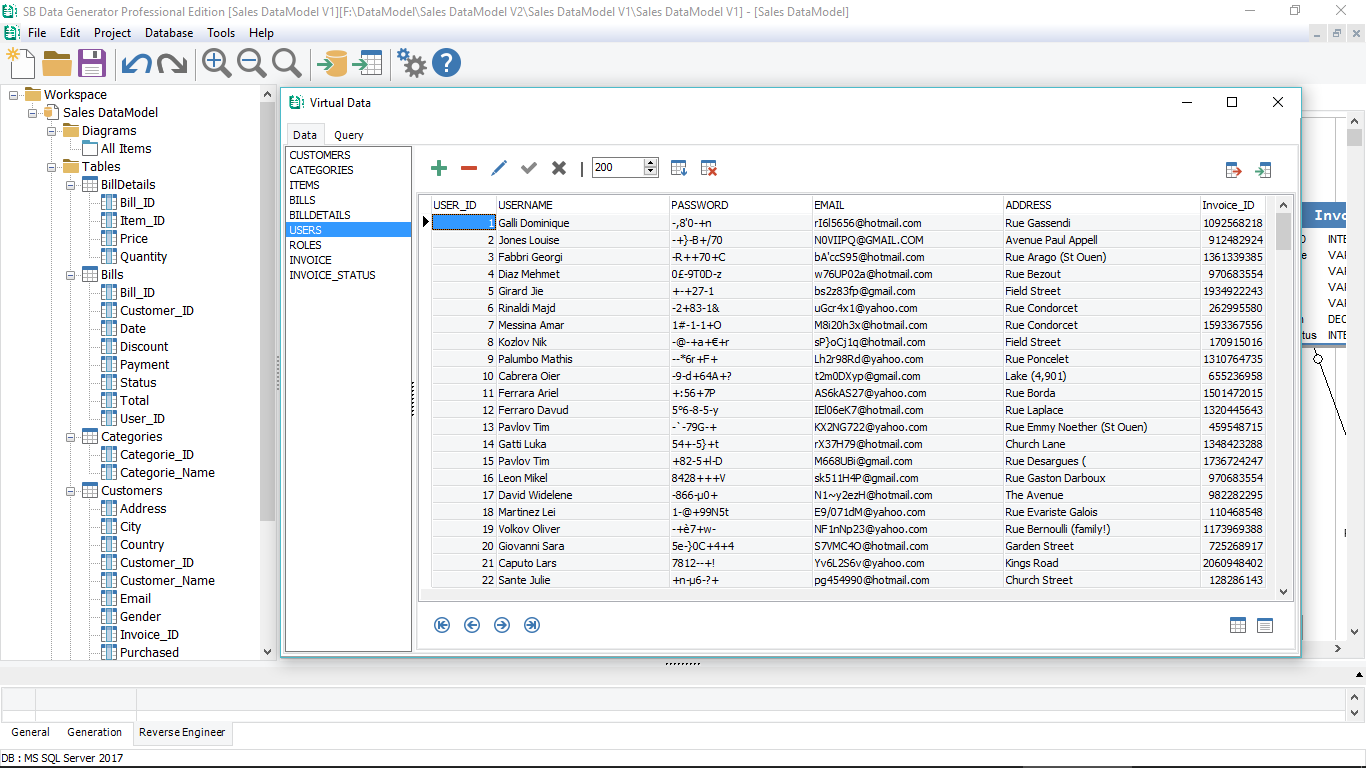
- #Sample data generator how to#
- #Sample data generator generator#
- #Sample data generator full#
- #Sample data generator software#
- #Sample data generator series#
For now, we’re only concerned with the following įor more options, see the file ‘SA-Eventgen/README/’. Within this file, the first stanza refers to the file you originally placed in your /samples directory.įollowing this, we have a lot of parameters to choose from. Here we will either need to create a ‘nf’ file, or we will need to modify one we have borrowed from the SA-Eventgen app (SA-EventGen/README/).
#Sample data generator generator#
Place a sample of the data you want the event generator to work with in this directory.įinally, we will need to go into $YOURAPP/local directory. You will also want to create a $YOURAPP/samples directory. When setting permissions for this app, it will need to be accessible by all of the other apps. This app requires you to restart Splunk, but hold off on this for now.įollowing this, create a new App for testing purposes if you do not have one already created. I would also recommend that you name the folder ‘SA-EventGen’.


Unzip and move the payload into your $SPLUNK_HOME/etc/apps directory. We will also be writing these events out to the /tmp directory. In this instance, I will be generating a copy every minute of the three events within a sample file, with entries in real-time.
#Sample data generator series#
The event generator works in one of two ways it can be used to either ‘replay’ the events within a file or series of files, or it can be used to randomly extract entries within the file and generate them at semi-random intervals, with particular fields or values changed per your specification.
#Sample data generator how to#
Clint has been kind enough to record a very thorough walkthrough of how to get your event gen up and running in just a few moments, but we’ll supply some more details and an overall outline of the application in subsequent posts.įor my first example, I will be using a simple data set (see below). If you would like to get started using it, follow this link. If you run into issues with this, please, please, please DO NOT contact Splunk Support or these individuals. OBLIGATORY NOTICE: This is also my opportunity to say that this is a tool, and is 100% UNSUPPORTED. With that said, I want to give a very big ‘thank you’ to the two very talented Splunkers that developed the app, David Hazekamp and Clint Sharp. I find this tool to be incredibly useful, and it is my intention to provide a walkthrough and a few posts on some of my experiences with it. Maybe you’re working on creating automation or workflow around a specific event or series of events that don’t occur that often, and you would like to test them today instead of waiting for a blue moon.Įnter the Splunk SA-Eventgen. Perhaps (as I’ve encountered), you need to work with a production dataset, but can’t get an active input from the production environment until your Splunk App is ready to go into production (catch-22 anyone?). Perhaps you have a great use case for Splunk, but you need to have a working application in order to justify a larger volume, but the data source is of such volume and velocity it could violate your license. You are working on a PoC and need to fiddle with your indexing or timestamps and you simply don’t want to keep re-indexing your original content. With the cross join you can generate a total combination of 341,658,256 users for your tests.Have you ever had a Splunk project that required a data feed, but for whatever reason it wasn’t practical to tap into the source itself? Examples of this could be We will use a cross join to generate all the possible combinations of names and last names. In the first example, we will use the DimCustomer table from the AdventureWorksDW database mentioned in the requirements.
#Sample data generator full#
Adventure Works 2014 Full and Adventure Works DW 2014 databases.In this article, we will teach how to generate up to a million rows of random data in SQL Server including:Ĭombinations of user names and last names

In general, random data is very useful for testing purposes, to learn about query efficiency, demos and more. In this article, we will give you some useful T-SQL tips that may help or at least inspire you on this.
#Sample data generator software#
That is why, it is very important to generate data and test the software with millions of rows.

If the provider had tested the software with millions of rows, this problem would have never happened. The customer sued to the software provider and lawyers were needed to create a resolution. The problem was not SQL Server, the problem was the application, which was not designed for tables with millions of rows. I once had a customer with software that worked fine in the demo with 30 rows, but after some months, the software had more than a million rows and it became very slow. In this article, we will talk about generating random values for testing purposes.


 0 kommentar(er)
0 kommentar(er)
